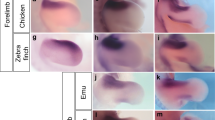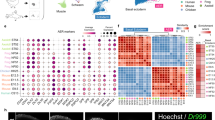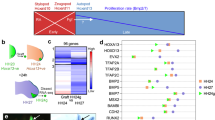Abstract
IT HAS been proposed that positional information in epimorphic fields is specified in terms of polar coordinates1, where one component of positional information is a value corresponding to position on a circle, and the other to position on a radius. In the newt limb, the circular sequence of positional values lies around the circumference and the radial sequence lies in the proximal–distal axis of the limb. French et al.1 have proposed that various different regulative phenomena in such epimorphic fields as insect legs, insect imaginal disks, and amphibian limbs can be accounted for by two principles of cellular behaviour. The first of these is shortest intercalation, whereby any discontinuities in positional information are resolved by intercalation of missing positional values during growth. The second principle is that distal transformation can only take place from a complete set of positional values in the circular sequence. Unless a complete circle is either present at a site of amputation, or can be generated by intercalation from an incomplete circle, no regeneration (distal transformation) will occur. These principles have been used to account for the number, location, handedness and orientation of supernumerary regenerates produced after grafting experiments in amphibians2 and insects3. The results reported here directly support the idea that a complete circle of positional values in the circular sequence is necessary for limb regeneration in adult newts.
This is a preview of subscription content, access via your institution
Access options
Subscribe to this journal
Receive 51 print issues and online access
$199.00 per year
only $3.90 per issue
Buy this article
- Purchase on Springer Link
- Instant access to full article PDF
Prices may be subject to local taxes which are calculated during checkout
Similar content being viewed by others
References
French, V., Bryant, P. J., and Bryant, S. V., Science, 193, 969–981 (1976).
Bryant, S. V., and Tten, L. E., Devl Biol. 50, 212–234 (1976).
French, V., J. Embryol. exp. Morphol., 35, 267–301 (1976).
Carlson, B. M., Devl Biol. 39, 263–285 (1974).
Lheureux, E., Wilhelm Roux's Arch., 176, 303–327 (1975).
Iten, L. E., and Bryant, S. V., Wilhelm Roux's Arch., 173, 263–282 (1973).
Weiss, P., Arch. Entwicklungsmech., 107, 1–53 (1926).
Weiss, P., Principles of Development (Holt, New York, 1939).
Goss, R. J., J. Morph., 100, 547–563 (1957).
Bohn, H., Wilhelm Roux's Arch., 156, 449–503 (1965).
Jacobson, A. G., in Methods in Developmental Biology (edit. by Wilt, F. H., and Wessells, N. K.), (Crowell, New York, 1967).
Bryant, S. V., and Iten, L. E., Wilhelm Roux's Arch., 174, 90–101 (1974).
Author information
Authors and Affiliations
Rights and permissions
About this article
Cite this article
BRYANT, S. Regenerative failure of double half limbs in Notophthalmus viridescens. Nature 263, 676–679 (1976). https://doi.org/10.1038/263676a0
Received:
Accepted:
Published:
Issue Date:
DOI: https://doi.org/10.1038/263676a0
This article is cited by
-
Limb regrowth takes two
Nature (2016)
-
FGF8 and SHH substitute for anterior–posterior tissue interactions to induce limb regeneration
Nature (2016)
-
Regeneration of reduplicated limbs in contravention of the complete circle rule
Nature (1978)
-
Supernumerary limbs in the axolotl
Nature (1978)
Comments
By submitting a comment you agree to abide by our Terms and Community Guidelines. If you find something abusive or that does not comply with our terms or guidelines please flag it as inappropriate.



